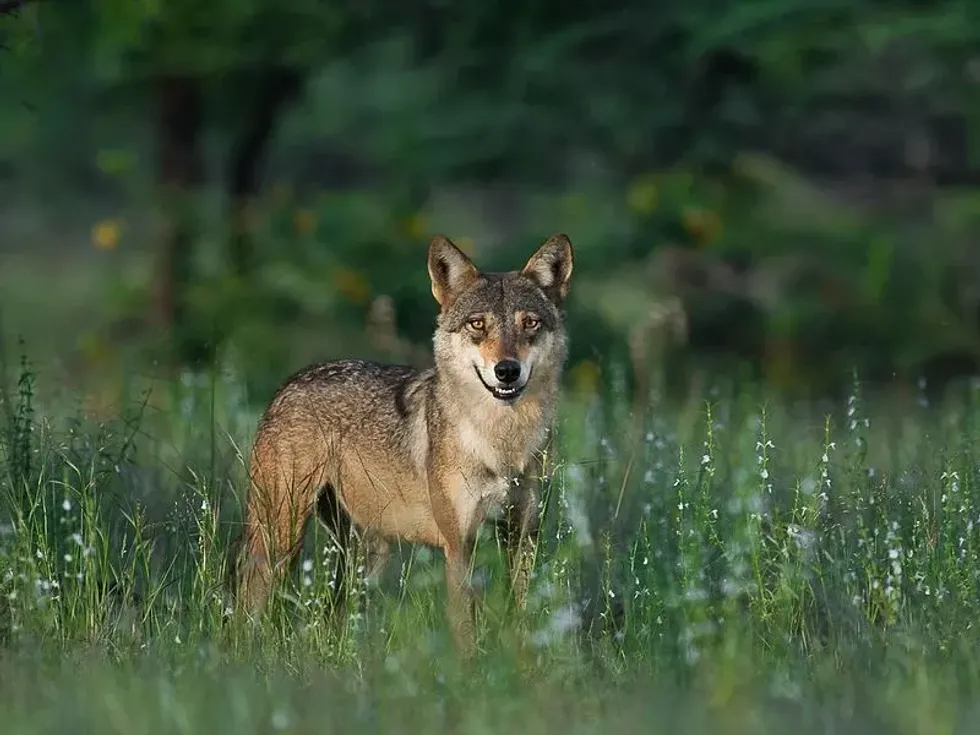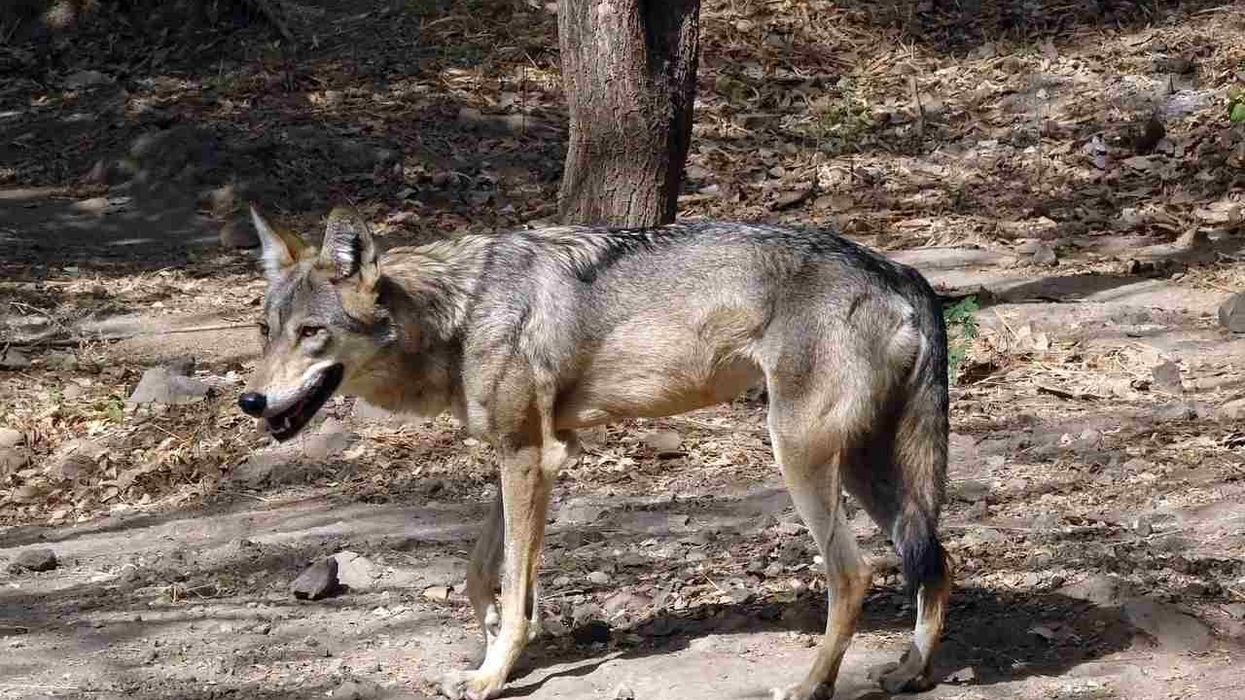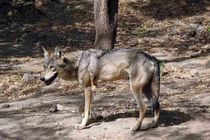Fun Indian Wolf Facts For Kids

The Indian wolf (Canis lupus pallipes) belongs to the Gray wolf (Canis lupus) group. This subspecies is classified into the Canis genus of the Canidae family.
They are known for being apex predators and one of the most dangerous ones in their family. However, history states that wolves used to be domestic animals and companions of humans several years ago.
Indian wolves are closely related in terms of appearance to other species of wolves of Central Asia. These wolves can survive in almost any type of climate. They are spotted in India, Pakistan, Afghanistan, Iran, Syria, Israel, Turkey, Nepal, and a small population in Bhutan.
This wild animal has a sad history with Indians, as a large number of people, especially children, lost their lives in wolf attacks. This tendency of attacking humans is not natural among their species.
People often mistake them for a fox. They have a thinner coating of fur, which is considered to be an adaptive genetic ability.
Many claims that Indian wolves originated as a mix between wolves and dogs. The diet chart of this carnivorous animal amidst the wildlife includes various types of rodents, raccoons, and hares.
When there is a scarcity of livestock in their natural habitat, they prey on domestic animals as well. They hunt and look for their food at night and can go several miles in search of prey and wildlife.
Interestingly, they have not received their conservation status from the International Union For Conservation Of Nature (IUCN). In India, they are protected as an Endangered species under the Wild Life (Protection) Act, of 1972. A sanctuary for wolves is soon to be made in the future, at Bankapur, India.
So, read on for more info about these animals. For other animals, take a look at these articles on the red wolf and Mexican wolf.
Indian Wolf Interesting Facts
What type of animal is an Indian wolf?
An Indian wolf (Canis lupus pallipes) is one of the subspecies of the Gray wolf (Canis lupus). These wild beasts are classified into the Canis genus of the Canidae family. They are apex predators, widely distributed in Asian countries. They are closely related to Eurasian Gray wolves and Arabian wolves.
What class of animal does an Indian wolf belong to?
Being a Gray wolf (Canis lupus) subspecies, Indian wolves belong to the Mammalia class of the Animalia kingdom.
How many Indian wolves are there in the world?
The Indian wolf species is widely distributed in multiple countries of Asia. Therefore, having an exact statistic of the total strength of their population is a bit difficult. However, approximately 2000-3000 wolves are found in India, and about 7000 individuals are found in Turkey.
Where does an Indian wolf live?
The distribution and populations of the Indian wolf are spread throughout the Asian continent. Populations are found in India, Pakistan, Afghanistan, Iran, Syria, Israel, Turkey, and Nepal, along with a small population in Bhutan.
In India, their distribution is spread across the states of Jammu and Kashmir, Uttarakhand, Karnataka, Kerala, Rajasthan, Maharashtra, Uttar Pradesh, and Andra Pradesh. If you want to spot Indian wolf packs, visit Panna Tiger Reserve and Velavadar National Park.
What is an Indian wolf's habitat?
The Indian wolves live in thorn forests, grasslands, and scrublands in Asian countries. Their habitat and behavior mainly depend on the quality and quantity of livestock available in that particular range.
They can survive in cold climates. For example, approximately 300 wolves are living in the Indian state of Jammu and Kashmir. They are spotted in arid and semi-arid regions of Rajasthan as well.
Who do Indian wolves live with?
An Indian wolf pack is relatively smaller in size than a pack of Gray wolves. An Indian wolf pack consists of six to eight wolves. They can hunt for their food in both groups and solo. Typically a wolf manages its food; however, they hunt in packs when the target is strong and much larger.
How long does an Indian wolf live?
The wolf pups gain their maturity at two years of age. Depending on the diet and location, the lifespan of Indian wolves ranges between five and six years. However, it has been observed that in captive populations, with proper nutrition and care, they can live up to 13 years as well.
How do they reproduce?
The mating and reproduction season of the Indian Wolves begins in mid-October and ends in late December. They prefer a warmer region for their pups to be born.
However, adult wolves can survive in most weather conditions. This Gray wolf subspecies follows the monogamous mating system. They form a pair and remain together for a lifetime.
The duration of the gestation period ranges between 62-75 days, and wolf pups are born in litters of five to six. It is the responsibility of all the pack members to protect the pups and their breeding range after reproduction and mating take place.
Indian wolves gain sexual maturity at the age of two. However, they wait until they step into adulthood to mate.
The pack consists of a dominant breeding pair, who can even prevent their subordinates from reproducing, as they want to remain as the only breeding pair. In rare scenarios, they can even physically harm others to prevent them from the act of reproduction.
Young wolves remain in their birth pack for two to three years until they step into adulthood. Post that period, they have the option to leave their birth pack, shift to a different location, and form their very own pack.
What is their conservation status?
The Indian wolf (Canis lupus pallipes) species is not listed in the International Union For Conservation of Nature (IUCN) Red List.
In India, their population had decreased dramatically during the British era when almost 100,000 wolves were killed. In the present day, this Gray wolf subspecies is protected and treated as an Endangered species by countries like India and Israel.
It is rumored that a sanctuary for wolves may be built shortly, at Bankapur, in the state of Karnataka, where the behavior and habits of the animal will be studied.
Indian Wolf Fun Facts
What do Indian wolves look like?
Comparing to other species, such as the Himalayan wolf, the Indian wolf doesn't have a thick layer of fur. Due to warmer temperatures in Indian subcontinents, they have a thin fur coats. It is one of their genetic survival adaptations.
From a distance, they may appear like a dog or a fox. Their coats are grayish-red, reddish-white, or black-colored. They have whitish underbelly and black furs on their shoulder.
The Indian wolf pups have a white patch on their chest. With growing age, the patch fades away.
They are much thinner, compared to any other subspecies of Grey wolves. In physical specifications, the Indian wolf resembles an Arabian wolf. After years of research, many biologists have claimed and speculated that this Grey wolf subspecies came into place as a result of a mix between a wolf and a dog!

How cute are they?
Compared to other subspecies of Grey wolves, perhaps Indian wolves are not so elegant! However, there is something about this animal that will never fail to mesmerize you. The wolf pups are adorable.
The sooty brown colored fur and the cute little white patch make them look adorable. Whoever has ever been lucky enough to listen to the howl of a wolf knows how phenomenal it sounds. However, they howl only in special scenarios.
How do they communicate?
They express their feelings through behavior such as barking, howling, and growling. Hearing a wolf howl can be a once-in-a-lifetime moment for any human being.
Along with that, they do various body postures and movements of their tails to communicate with each other. They have a strong sense of smell. Thereby, they can mark their territories by their scent.
How big is an Indian wolf?
The length of an Indian wolf ranges between 41–57 in (103–145 cm) in length and 22–28 in (57–72 cm) in height. They are much thinner than any other Grey wolf subspecies. Compared to the Canadian Timber wolf, they are approximately 8-10 in (20.3-25.4 cm) shorter in height.
How fast can an Indian wolf run?
Indian wolves are apex predators. They can cover major distances with ease while chasing prey. They can maintain a speed of 34 mph (55 kph). The Eurasian gray wolves are the fastest of their group, with an amazing speed of up to 43 mph (70 kph).
How much does an Indian wolf weigh?
Depending on their diet and region, the weight of Indian wolves ranges between 37.4-55.1 lb (17-25 kg). The male wolves weigh about 42-55 lb (19-25 kg), and the females 37-49 lb (17-22 kg). Compared to a Himalayan wolf, an Indian wolf is quite lighter in weight. The Himalayan wolves can weigh up to 77 lb (35 kg).
What are the male and female names of the species?
Male Indian wolves are known as dogs, and there is no particular name given to females. However, in popular cultures, they are referred to as she-wolves.
What would you call a baby Indian wolf?
Baby Indian wolves are called pups.
What do they eat?
Similar to other species of wolves, Indian wolves are carnivorous animals. Depending on the region, they can occupy the top position of their food chain. Indian wolves prey on various types of rodents, antelopes, raccoons, and hares.
During scarcity of livestock in their range, they can prey on domestic animals as well. Similar to other species of wolves, the Indian wolves hunt for their food in packs, usually at night. They can hunt solo as well when the prey is an easy target.
Are they dangerous?
Wolves are indeed dangerous animals. Perhaps it won't be wrong to claim that an Indian wolf is one of the most dangerous of all wolf species.
They have a bad history with humans, especially having killed numerous citizens of India. According to records and numbers in India, in 1878, 638 Indians lost their lives, including children, in Indian wolf attacks, and in 1900 the total casualty was 285. Human children are prone to be sought as prey by Indian wolves.
Not only that, they are dangerous to domestic animals as well. These wolves consider domestic animals as their prey when their natural environment is scarce with livestock.
Would they make a good pet?
Some subspecies of Grey wolves can be a pet with proper training. Even historians claim that wolves used to be loyal companions of humans several years ago. However, Indian wolves don't fall under that list, especially because they are a nightmare for children. These are wild animals and can't be tamed at any cost.
Did you know...
Many people search on Google about the smallest and largest wolf species. The Canadian Timberwolves of North America are popular as the largest wolves. On the other hand, the Arabian wolf (Canis lupus arabs) is the smallest one. They stand about 25–26 in (64–66 cm) tall at the shoulder.
If you are aware of the 'Jungle Book' by renowned author Rudyard Kipling, then you already know what a major character was the wolf named Akela.
What is the largest species of the wolf?
The Canadian Timber wolf (Canis lupus occidentalis) from North America, also known as the Mackenzie Valley Wolf, is the largest species of wolf in our world. These humongous animals stand 26.8- 36.0 in (68- 91.5 cm) tall at the shoulder - talk about majestic creatures!
Is the Indian wolf endangered?
Indian wolves are Not Listed in the International Union For Conservation of Nature (IUCN) Red List even though the number of wolves in the wild did decrease a century ago. Now, in India, they are treated as an Endangered species.
They fall under Schedule I of Indian Wildlife according to the Wild Life (Protection) Act, 1972. According to rumors, a wolf sanctuary may be built shortly at Bankapur, India.
Here at Kidadl, we have carefully created lots of interesting family-friendly animal facts for everyone to discover! Learn more about some other mammals from our Bengal tiger fun facts for kids and common wombat facts pages.
You can even occupy yourself at home by coloring in one of our free printable Indian wolf coloring pages.
We Want Your Photos!
More for You
See All
Bachelor of Arts specializing in Journalism and Mass Communication, Postgraduate Diploma in Sports Management

Moumita DuttaBachelor of Arts specializing in Journalism and Mass Communication, Postgraduate Diploma in Sports Management
A content writer and editor with a passion for sports, Moumita has honed her skills in producing compelling match reports and stories about sporting heroes. She holds a degree in Journalism and Mass Communication from the Indian Institute of Social Welfare and Business Management, Calcutta University, alongside a postgraduate diploma in Sports Management.
Bachelor of Law

Abdulqudus MojeedBachelor of Law
A versatile professional with a passion for creative writing and technology. Abdulqudus is currently pursuing his Bachelor of Law from the University of Lagos and has experience as a tutor, intern assistant, and volunteer. He possesses strong organizational skills and is a detail-oriented person.
Disclaimer
1) Kidadl is independent and to make our service free to you the reader we are supported by advertising. We hope you love our recommendations for products and services! What we suggest is selected independently by the Kidadl team. If you purchase using the Buy Now button we may earn a small commission. This does not influence our choices. Prices are correct and items are available at the time the article was published but we cannot guarantee that on the time of reading. Please note that Kidadl is a participant in the Amazon Services LLC Associates Program, an affiliate advertising program designed to provide a means for sites to earn advertising fees by advertising and linking to Amazon. We also link to other websites, but are not responsible for their content.
2) At Kidadl, we strive to recommend the very best activities and events. We will always aim to give you accurate information at the date of publication - however, information does change, so it’s important you do your own research, double-check and make the decision that is right for your family. We recognise that not all activities and ideas are appropriate for all children and families or in all circumstances. Our recommended activities are based on age but these are a guide. We recommend that these ideas are used as inspiration, that ideas are undertaken with appropriate adult supervision, and that each adult uses their own discretion and knowledge of their children to consider the safety and suitability. Kidadl cannot accept liability for the execution of these ideas, and parental supervision is advised at all times, as safety is paramount. Anyone using the information provided by Kidadl does so at their own risk and we can not accept liability if things go wrong.
3) Because we are an educational resource, we have quotes and facts about a range of historical and modern figures. We do not endorse the actions of or rhetoric of all the people included in these collections, but we think they are important for growing minds to learn about under the guidance of parents or guardians.







